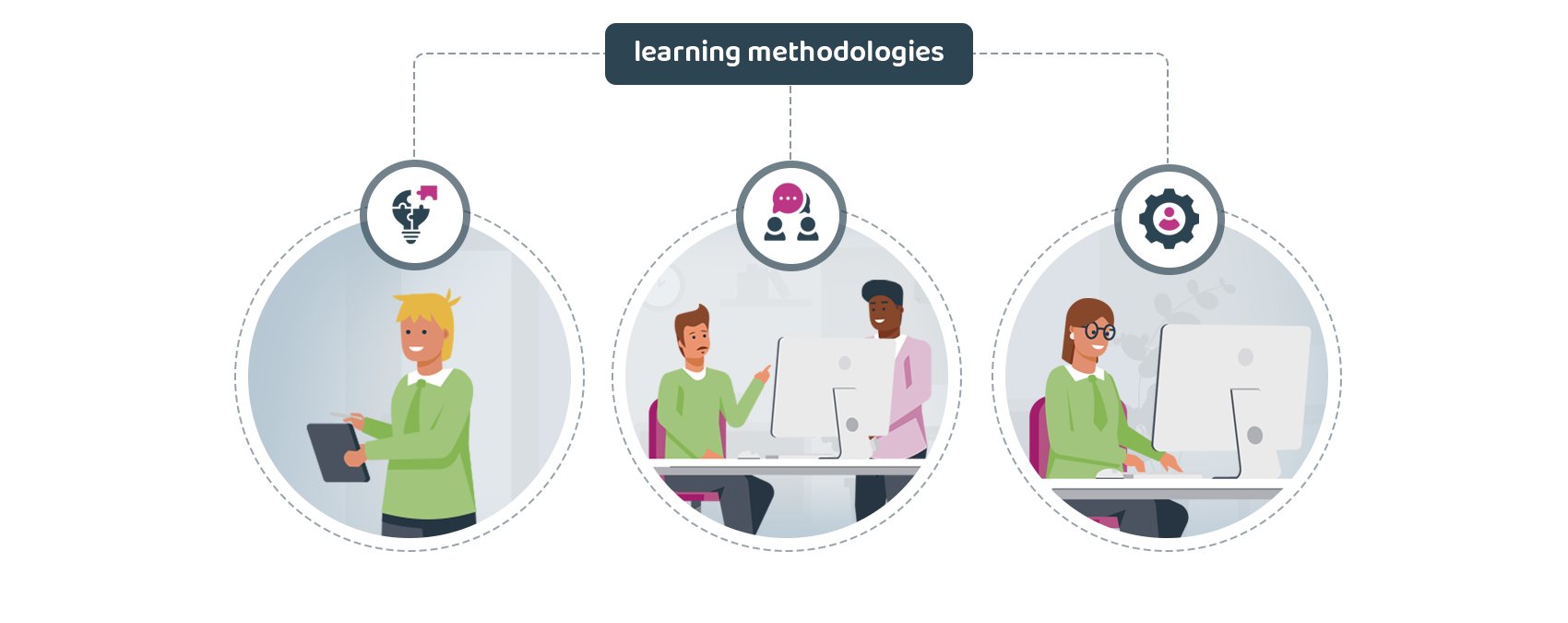We were happy to recently host Bachelor of Arts student Cleo Newling as a Guroo intern. During her time with us, Cleo created this reflective piece on approaches to learning design. If you're considering a future in learning design, click here to find out how you can get involved with the Guroo Learning Design Graduate Program.
Combining different learning methodologies can be a great way to structure your learning experiences. You’re able to adjust how your content is delivered to complement all types of learners. To achieve the desired outcomes for your learner, it’s important to find a learning methodology that best suits your content. You are then able to equip your learners to thrive in an educational context and make the most of their learning experience.
The unique mode of eLearning provides the opportunity for a more innovative and tailored-to-the-learner approach, encouraging learners to be independent and internally motivated. Learners can work at their own pace, and fit learning around their busy schedule. In this article, we explore three approaches to learning design that you can draw upon as you think about developing your own approaches to structuring and designing learning experiences.
 Andragogy
Andragogy
Andragogy recognises the decentralised approach required of adult learning, with a focus on independence and self-motivation. Andragogy emphasises that learners should have a clear view of the objectives and outcomes – they must know why they are learning. Therefore, it’s encouraged that learners are involved in the process of structuring their own learning.
Independence and reflection are at the core of this methodology. It’s expected that learners will draw upon their prior learning experience. Their autonomous learning experience should maintain a balance of external guidance and self-discipline.
Pros
-
Clear focus and motivation for learning
-
Learning plans are individualised based on the learner’s experience
-
Learners are actively involved in their course plan and assessments
-
The curriculum is application-based and revolves around real-life scenarios
Cons
-
May require a less structured approach
-
Requires highly motivated learners
What this looks like
-
The role of the instructor is closer to that of a facilitator or learning resource, rather than the traditionally authoritative lecturer or marker
-
A moderate level of guidance and instruction allows learners to discover knowledge for themselves, with support provided when mistakes are made
-
Learning should move beyond simply acquiring subject matter, encouraging learners to perform practical tasks and solve problems
 Heutagogy
Heutagogy
Also known as self-determined learning, Heutagogy is a student-centred methodology that functions without the guidance of instructors. Students are encouraged to seek their own problems and challenge their learning by consistently finding areas of uncertainty and complexity in their subject.
A continual process of questioning is aided by learning resources and provides a context for both reflection and problem-solving strategies from the learner. Learners are involved in their own assessment process and continually self-assess. This is easily implemented in an eLearning context.
Pros
-
Learners can negotiate how their learning is structured
-
Emphasises autonomy of the learner as they move through content in a critical way
-
Learning is supported by reflective practice
-
Self-assessment helps learners evaluate their understanding
Cons
-
Emphasis on collaboration, which may not be convenient for an eLearning context
-
Learners are motivated to seek their own resources which may prove unnecessary for some topics
What this looks like
-
Custom learning plan determined by a series of questions the learner can answer prior to beginning their course
-
Depending on the design of your program, resources might not be exhaustive, you can encourage students to continue their ongoing learning journey outside prescribed materials
-
Questions to assess learning will encourage reflection, insight, and exploration rather than merely restating content
-
Assessments are flexible and designed as a demonstration of the student’s capability and competency in novel situations to help develop capable learners and practitioners
 Transformative Learning
Transformative Learning
As its title suggests, transformative learning aims to challenge learners to re-assess their assumptions, expectations, and beliefs. Aspects of their prior knowledge are essentially “transformed” as they are confronted with new knowledge and approaches. The methodology involves a hands-on method of procedural tasks, problem-solving and self-reflection.
Transformative learning is best utilised in situations where an individual is required to critically reflect and shift their perspective, behaviour, or interactions. Learning takes place with the aid of action plans, case studies, and critical-theory activities. Reflection is particularly important in allowing learners to step out of familiar habits and understand new ways of thinking.
Pros
-
Challenges learners to evaluate and change their perspective
-
Practices of critical reflection to enhance self-awareness and promote self-understanding
-
Flexible and suited to workplace culture training or personal development
-
Promotes tangible change and innovation in learners
Cons
-
Peer collaboration is recommended, which may not be suited for an eLearning context
-
May be considered a more emotional than rational approach
What this looks like
-
Content designed to change outdated perspectives or re-train employees in soft skills
-
A series of short, thought-provoking questions at the beginning of the course to guide your learner into the topic
-
Including the practice of a reflective journal throughout the program to encourage thoughtful and active learners

.png)

